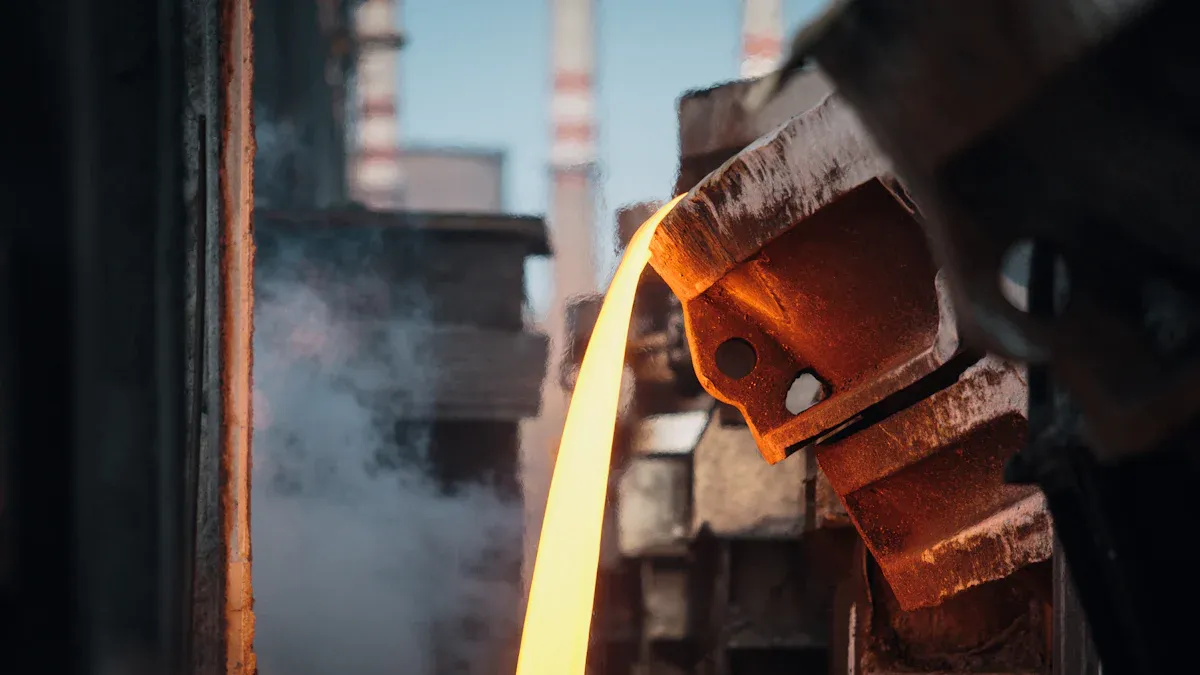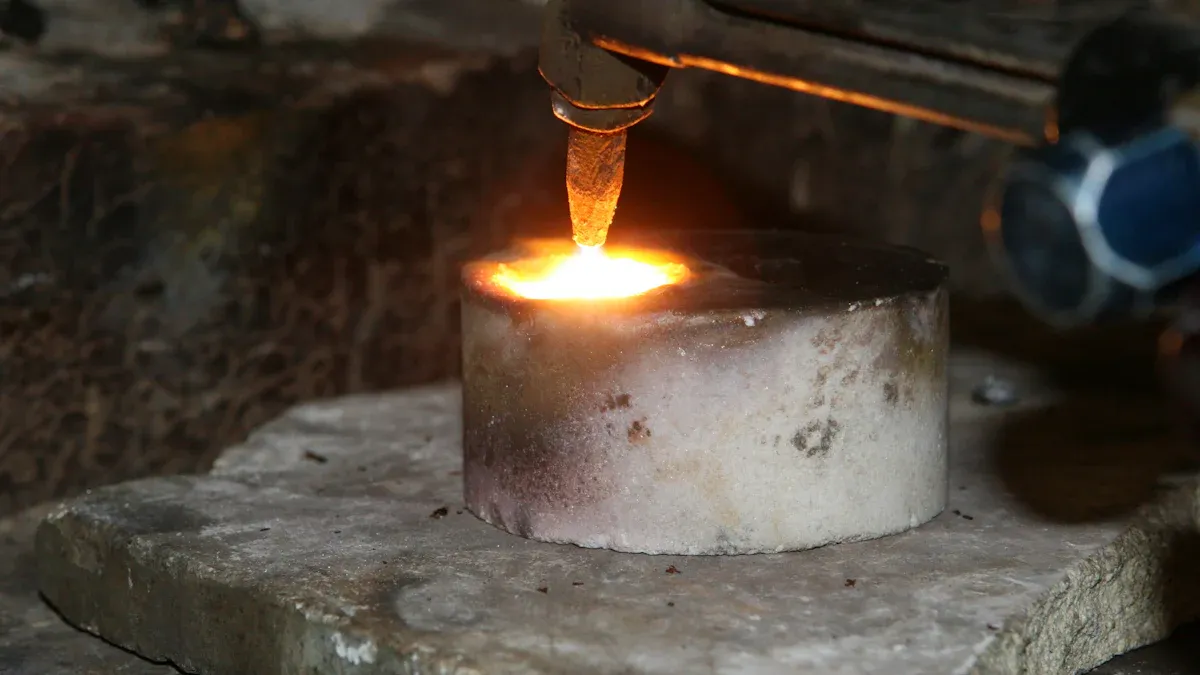How Metal Die Casting Works and Its Key Advantages

The Metal Die Casting process shapes molten metal into precise components using reusable molds. This method ensures consistent quality and high efficiency, especially in industries like automotive die casting. A specialized technique, the centrifugal metal die casting process, enhances accuracy by spinning molten material to remove impurities, resulting in stronger, flawless parts.
Key Takeaways
- Metal Die Casting shapes melted metal into exact parts using molds. These molds can be used again, ensuring good quality and speed.
- This method is great for making detailed designs with exact sizes. It is perfect for industries like cars and airplanes.
- Spinning the metal during casting removes dirt and spreads it evenly. This makes parts stronger and without flaws.
The Metal Die Casting Process

Overview of the Metal Die Casting Process
The Metal Die Casting process is a manufacturing method that transforms molten metal into precise, reusable shapes. You start with a mold, often made from steel or other durable materials, which acts as a template for the final product. This mold is designed to withstand high temperatures and repeated use. The process involves injecting molten metal into the mold under high pressure. This pressure ensures the metal fills every corner of the mold, creating a detailed and accurate component.
Unlike other casting methods, this process is highly efficient and produces parts with excellent surface finishes. You can use it to create complex shapes that would be difficult or impossible to achieve with other techniques. Industries like automotive, aerospace, and electronics rely on this method for its precision and reliability.
Tip: If you need components with intricate designs and tight tolerances, the Metal Die Casting process is one of the best options available.
Key Steps in the Process
The Metal Die Casting process follows a series of well-defined steps to ensure consistent results:
- Preparation of the Mold:
The mold is cleaned and coated with a lubricant. This lubricant helps regulate temperature and makes it easier to remove the finished part. - Melting the Metal:
The metal is heated until it becomes molten. Common materials include aluminum, zinc, and magnesium. - Injection of Molten Metal:
The molten metal is injected into the mold at high pressure. This step ensures the metal fills every detail of the mold. - Cooling and Solidification:
The metal cools and solidifies inside the mold. This step is crucial for achieving the desired strength and shape. - Ejection of the Part:
Once the metal has solidified, the mold opens, and the finished part is ejected. - Trimming and Finishing:
Excess material, known as flash, is removed. The part may also undergo additional finishing processes, such as polishing or coating.
Each step plays a vital role in ensuring the final product meets your specifications. By following these steps, manufacturers can produce high-quality components with minimal waste.
Comparison of Die Casting with Other Casting Methods
When you compare the Metal Die Casting process to other casting methods, its advantages become clear.
| Feature | Die Casting | Sand Casting | Investment Casting |
|---|---|---|---|
| Precision | High | Moderate | High |
| Production Speed | Fast | Slow | Moderate |
| Surface Finish | Excellent | Rough | Good |
| Cost for Large Volumes | Cost-effective | Expensive | Expensive |
Die casting stands out for its speed and precision. Sand casting, while versatile, often results in rougher finishes and slower production times. Investment casting offers high precision but comes with higher costs and longer lead times. If you need large quantities of parts with consistent quality, die casting is the ideal choice.
Note: While other methods have their strengths, the Metal Die Casting process excels in applications where precision, speed, and cost-effectiveness are critical.
Advantages of the Metal Die Casting Process
Precision and Efficiency
The Metal Die Casting process delivers unmatched precision. You can achieve intricate designs and tight tolerances that other methods struggle to replicate. This precision ensures that every component fits perfectly into its intended application. The process also excels in efficiency. High-pressure injection fills molds quickly, reducing production time. This speed makes it ideal for large-scale manufacturing, where you need consistent quality across thousands of parts.
Did you know? The Metal Die Casting process can produce parts with surface finishes so smooth that they often require little to no additional machining.
Cost-Effectiveness and Sustainability
Die casting offers significant cost savings, especially for high-volume production. Reusable molds reduce material waste, and the process minimizes the need for secondary operations. You also benefit from sustainability. Many metals used in die casting, like aluminum and zinc, are recyclable. This makes the process an eco-friendly choice for manufacturers looking to reduce their environmental impact.
Durability and Strength of Components
Components made through die casting are known for their durability. The high-pressure injection ensures a dense, uniform structure, which enhances strength. You can rely on these parts to withstand wear and tear, even in demanding applications like automotive or aerospace. Additionally, the process allows for the use of alloys that combine lightweight properties with exceptional strength.
Tip: If you need parts that last longer and perform better, die casting is a reliable option.
Centrifugal Forming: A Specialized Technique

How Centrifugal Forming Works
Centrifugal forming is a unique manufacturing method that uses centrifugal force to shape molten metal. In this process, you pour molten metal into a spinning mold. The rotation creates a force that pushes the metal outward, ensuring it spreads evenly along the mold’s walls. This technique removes impurities by forcing them toward the center, where they can be easily removed after cooling.
The spinning motion also helps the metal solidify with a uniform density. This results in parts that are free from internal defects, such as air pockets or weak spots. Unlike traditional methods, centrifugal forming relies on physics rather than external pressure to achieve precision.
Fun Fact: The faster the mold spins, the greater the force applied to the molten metal. This allows manufacturers to control the density and quality of the final product.
Benefits of Centrifugal Forming
Centrifugal forming offers several advantages that make it a valuable addition to the Metal Die Casting process:
- Improved Material Quality: The process eliminates impurities, resulting in stronger and more reliable components.
- Enhanced Precision: The even distribution of molten metal ensures consistent thickness and accuracy.
- Cost Efficiency: By reducing material waste and minimizing defects, you save on production costs.
- Versatility: This method works well with a variety of metals, including aluminum, steel, and bronze.
The combination of these benefits makes centrifugal forming ideal for industries that demand high-quality parts, such as aerospace and automotive manufacturing.
Tip: If you need components with superior strength and flawless finishes, centrifugal forming is an excellent choice.
Applications of Centrifugal Forming in Manufacturing
You’ll find centrifugal forming used in a wide range of industries. Its ability to produce durable and precise parts makes it especially popular in the following applications:
- Automotive Industry: Manufacturers use this technique to create engine components, brake drums, and other critical parts.
- Aerospace Sector: The process is ideal for producing lightweight yet strong components, such as turbine rings and casings.
- Piping and Tubing: Centrifugal forming is perfect for creating seamless pipes and tubes that can withstand high pressure.
- Energy Production: Power plants rely on this method to produce parts for turbines and generators.
The versatility of centrifugal forming ensures its relevance across multiple fields. Whether you need precision, durability, or cost savings, this technique delivers exceptional results.
Note: Centrifugal forming complements the Metal Die Casting process by offering additional options for creating high-quality components.
The Metal Die Casting process transforms molten metal into precise, durable components through efficient steps like mold preparation, injection, and cooling. Centrifugal forming enhances this by delivering flawless, high-strength parts. Explore these methods to improve your manufacturing outcomes.
Tip: Die casting combines precision, speed, and cost savings, making it ideal for large-scale production.
FAQ
What metals can you use in the die casting process?
You can use metals like aluminum, zinc, magnesium, and copper alloys. Each offers unique properties for different applications.
How does die casting ensure precision?
High-pressure injection fills molds completely, creating detailed shapes with tight tolerances. This method guarantees consistent accuracy across all components.
Is die casting environmentally friendly?
Yes! Reusable molds and recyclable metals reduce waste. The process supports sustainability by minimizing material usage and energy consumption.
Tip: Choose aluminum for lightweight, durable parts or zinc for intricate designs.